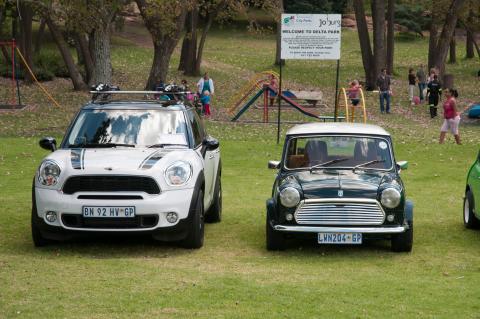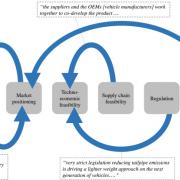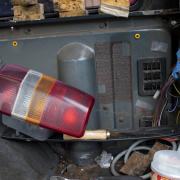We can achieve our emissions cut to 25% of today’s levels while having access to the same level of personal transport in cars: we just need small, light cars with low acceleration and top speed, and we can hit our target, by using less.
To a first approximation, all modes of transport lead to approximately the same greenhouse emissions for each kilogramme-kilometre (see Figure 1). This unfamiliar unit is important – the energy required to move people and things, and the consequent emissions is a function of two main variables – the weight and the distance, and of course the weight includes the weight of the vehicle.
| Key Points |
|
In a perfect world with no losses, Sir Isaac Newton’s second law of motion tells us that we don’t actually need any net energy for a journey: I could begin my day by standing on a spring outside my house in Cambridge, release the spring which would project me (in a frictionless superman suit) through the air in a perfect parabola, to land at the department of engineering on an identical spring, which would capture from me exactly the energy required for my return journey in the evening. I haven’t so far been brave enough to try this journey, and unfortunately some unwanted losses would act against this or any other approach. But the idea shows how we need energy to power transport to overcome losses from inertia, mechanical resistance and the drag of air or water. Inertial forces, familiar from cycling uphill or from accelerating away from the traffic lights, are required to increase the vehicles kinetic or potential energy, and the work they do could in theory be recovered by regenerative systems. The best way to reduce inertial losses is to reduce the weight being moved. Mechanical resistance occurs due to friction, between mechanical components, and between the wheels of a rolling vehicle and its road or track. These are also reduced in proportion to vehicle weight but are also influenced by lubrication and tyre hardness – the harder the tyre the better. The drag forces are proportional to the vehicles frontal area (the smaller the better), it’s shape (a teardrop shape is best) and its speed squared. The last term is very important – at low speeds (for a car, this means when driving in town) the car uses fuel mainly to overcome inertia and mechanical resistance, but at high speeds (over 50mph on the motorway) aerodynamic drag is most important.
Modes of Transport
|
"On average, making a 1.5 tonne car currently requires that we make up to three tonnes of energy intensive material – because the car industry scraps around half of all the material it buys."
|
Thinking through the different modes of transport, we can now see that long-haul aircraft have the highest emissions – they travel at very high speeds, with a heavy load of fuel in addition to the passengers and vehicle structure. Freight ships are the most efficient – they travel at one constant speed which perfectly matches the most efficient sweet-spot of their engines, make few turns, and the main use of energy is to overcome drag from the water. Because this force increases with the square of their speed, if they travelled 10% slower, they would use 19% less energy. Bicycles are efficient, because the vehicles weight very little compared to the rider, and the frontal area is determined by the size of the rider. Olympic cyclists use the lightest possible bikes, they lean over so their trunk is parallel to the track to reduce their frontal area to a minimum, and their specially shaped helmets and suits are designed to give them the most slippery tear-drop shapes.
The fact that all modes of transport have similar emissions per unit distance suggests that it doesn’t really matter which way we travel. However, the speed of travel is obviously very different, so the graph shows the emissions per hour of travel. Suddenly flying looks to be very damaging. Flying for 40 hours per year (which might for example mean one return to Australia, three transatlantic return trips, or twenty short hall returns within northern Europe) causes around 10 tonnes of CO2 which is the same as the average year emissions of UK citizens per year. Most people in the world don’t fly, but those that do fly tend to fly at all. For most people who use aeroplanes, flying will be the largest part of their carbon footprint.
|
"There isn’t a miracle fuel to power today’s cars, and we won’t find radical new efficiencies when we’re hurtling around in massive boxes."
|
"Better" cars
If we look at a pie chart (Figure 2) of all emissions arising from transport the car is the dominant vehicle, yet when we look at the history of fuel consumption in cars, we appear to have made very little progress in the past fifty years. We already know that the engines are designed with maximum efficiency in converting fuel to mechanical power, and this efficiency has improved dramatically since the 1950’s, motivated among other things by (male) enthusiasm for rushing around tracks in racing cars. The reason for this is that we’ve chosen to use this expansion in engine efficiency to drive larger cars (the most attractive peacock has the biggest tail feathers) with greater acceleration (due to men’s ignorance of what women want.) For example, in the late 1970’s the two oil shocks that created fear of international shortage drove American car manufacturers to reduce the weight of new cars by a third, and increase their fuel efficiency by 50%. However, since 1980, they have instead increased the weight of the vehicle again, increased its frontal area, and increased its acceleration, with no further improvement in fuel consumption.
If we take a look at new cars on sale in the UK today, and plot them on a graph of fuel consumption against weight (Figure 3), it’s obvious that fuel efficient cars are lighter (and therefore smaller.) We know how to make fantastically fuel efficient cars: the world record PAC II car achieved 10,000 miles per gallon (by being very light, very small and travelling slowly), and with just two modifications, an entrant in the Shell eco-marathon achieved 160 mpg in a Lotus 7 (a car that’s already small and light).

There’s also a double benefit in moving to smaller lighter cars. On average, making a 1.5 tonne car currently requires that we make up to three tonnes of energy intensive material – because the car industry scraps around half of all the material it buys. (It buys coils of metal with constant width, but cars are designed with fluid shapes that must be cut out of these strips, leaving behind as much scrap as car.) As a result, over the typical 14 year lifespan of a car, we can estimate that making the car takes about one fifth of the energy of using it. If we made smaller cars from the same types of material, this ratio would remain the same, so the emissions of the car industry and the materials industries that supply it, would all go down in proportion to the drop in vehicle weight.
Current policy in the European Union is promoting electric cars, but the graphs here show that this is not the right priority. We don’t currently have excess low carbon electricity, so shifting to electric cars charged of today’s national grid, there is only a small saving in emissions in use – perhaps 20-30% at most – and the energy cost of production is probably increased, when allowing for the complexity of producing and disposing of the batteries. Instead, if we focus firstly on reducing the weight of the vehicles – which reduces emissions however they’re powered – and only then on converting to electric transmissions, we would have a much better strategy (Figure 4).
|
"We just need small, light cars with low acceleration and top speed, and we can hit our target, by using less." |
We could all be driving 200 mile per gallon cars next year, if we told the car manufacturers we wouldn’t buy anything else. We don’t want electric cars until there’s excess low carbon electricity going spare. We want small light cars, with low acceleration and low top speeds, so we can enjoy our journeys with a new experience of place, scenery and companionship. There isn’t a miracle fuel to power today’s cars, and we won’t find radical new efficiencies when we’re hurtling around in massive boxes. But we can achieve our emissions cut to 25% of today’s levels while having access to the same level of personal transport in cars. We just need small, light cars with low acceleration and top speed, and we can hit our target, by using less.
Our extensive output on transport consumption includes:-



